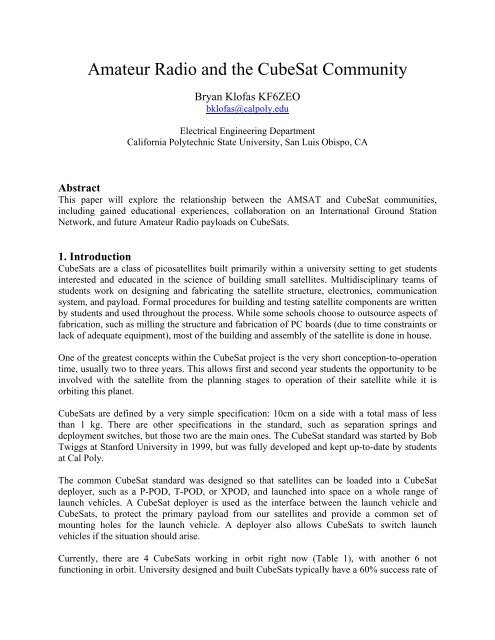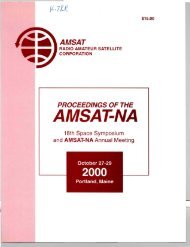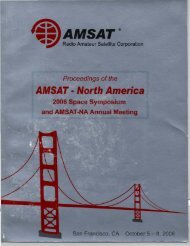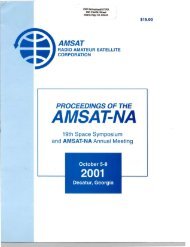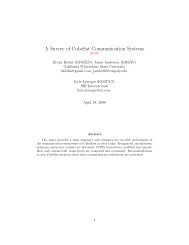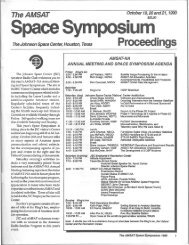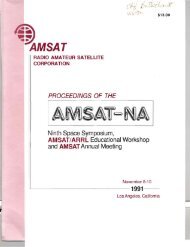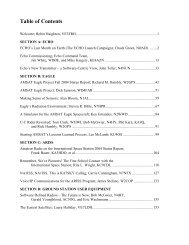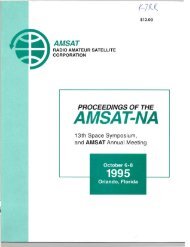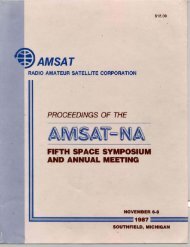Amateur Radio and the CubeSat Community - Klofas.com
Amateur Radio and the CubeSat Community - Klofas.com
Amateur Radio and the CubeSat Community - Klofas.com
You also want an ePaper? Increase the reach of your titles
YUMPU automatically turns print PDFs into web optimized ePapers that Google loves.
<strong>Amateur</strong> <strong>Radio</strong> <strong>and</strong> <strong>the</strong> <strong>CubeSat</strong> <strong>Community</strong><br />
Bryan <strong>Klofas</strong> KF6ZEO<br />
bklofas@calpoly.edu<br />
Electrical Engineering Department<br />
California Polytechnic State University, San Luis Obispo, CA<br />
Abstract<br />
This paper will explore <strong>the</strong> relationship between <strong>the</strong> AMSAT <strong>and</strong> <strong>CubeSat</strong> <strong>com</strong>munities,<br />
including gained educational experiences, collaboration on an International Ground Station<br />
Network, <strong>and</strong> future <strong>Amateur</strong> <strong>Radio</strong> payloads on <strong>CubeSat</strong>s.<br />
1. Introduction<br />
<strong>CubeSat</strong>s are a class of picosatellites built primarily within a university setting to get students<br />
interested <strong>and</strong> educated in <strong>the</strong> science of building small satellites. Multidisciplinary teams of<br />
students work on designing <strong>and</strong> fabricating <strong>the</strong> satellite structure, electronics, <strong>com</strong>munication<br />
system, <strong>and</strong> payload. Formal procedures for building <strong>and</strong> testing satellite <strong>com</strong>ponents are written<br />
by students <strong>and</strong> used throughout <strong>the</strong> process. While some schools choose to outsource aspects of<br />
fabrication, such as milling <strong>the</strong> structure <strong>and</strong> fabrication of PC boards (due to time constraints or<br />
lack of adequate equipment), most of <strong>the</strong> building <strong>and</strong> assembly of <strong>the</strong> satellite is done in house.<br />
One of <strong>the</strong> greatest concepts within <strong>the</strong> <strong>CubeSat</strong> project is <strong>the</strong> very short conception-to-operation<br />
time, usually two to three years. This allows first <strong>and</strong> second year students <strong>the</strong> opportunity to be<br />
involved with <strong>the</strong> satellite from <strong>the</strong> planning stages to operation of <strong>the</strong>ir satellite while it is<br />
orbiting this planet.<br />
<strong>CubeSat</strong>s are defined by a very simple specification: 10cm on a side with a total mass of less<br />
than 1 kg. There are o<strong>the</strong>r specifications in <strong>the</strong> st<strong>and</strong>ard, such as separation springs <strong>and</strong><br />
deployment switches, but those two are <strong>the</strong> main ones. The <strong>CubeSat</strong> st<strong>and</strong>ard was started by Bob<br />
Twiggs at Stanford University in 1999, but was fully developed <strong>and</strong> kept up-to-date by students<br />
at Cal Poly.<br />
The <strong>com</strong>mon <strong>CubeSat</strong> st<strong>and</strong>ard was designed so that satellites can be loaded into a <strong>CubeSat</strong><br />
deployer, such as a P-POD, T-POD, or XPOD, <strong>and</strong> launched into space on a whole range of<br />
launch vehicles. A <strong>CubeSat</strong> deployer is used as <strong>the</strong> interface between <strong>the</strong> launch vehicle <strong>and</strong><br />
<strong>CubeSat</strong>s, to protect <strong>the</strong> primary payload from our satellites <strong>and</strong> provide a <strong>com</strong>mon set of<br />
mounting holes for <strong>the</strong> launch vehicle. A deployer also allows <strong>CubeSat</strong>s to switch launch<br />
vehicles if <strong>the</strong> situation should arise.<br />
Currently, <strong>the</strong>re are 4 <strong>CubeSat</strong>s working in orbit right now (Table 1), with ano<strong>the</strong>r 6 not<br />
functioning in orbit. University designed <strong>and</strong> built <strong>CubeSat</strong>s typically have a 60% success rate of
turning on when deployed into space. While this success rate may seem extremely low,<br />
remember that <strong>the</strong> primary purpose of this project is education. The objectives of <strong>the</strong> project<br />
have been fulfilled whe<strong>the</strong>r <strong>the</strong> satellite works in space or not.<br />
Satellite School Launch Frequency Payload<br />
XI-IV University of Tokyo 30 June 2003 437.490 MHz Camera<br />
QuakeSat Stanford/Quakefinder 30 June 2003 436.675 MHz VLF receiver<br />
XI-V University of Tokyo 27 October 2005 437.345 MHz Camera<br />
CUTE-1 Tokyo Institute of<br />
Technology<br />
21 February 2006 437.505 MHz Attitude<br />
determination<br />
Table 1: Operational <strong>CubeSat</strong>s as of September 2006<br />
One might <strong>com</strong>ment on how much space junk we are adding to space. While this has been true in<br />
<strong>the</strong> past, due to <strong>the</strong> FCC’s new orbital debris mitigation plan [1], things are changing. Methods to<br />
de-orbit spacecraft are being developed <strong>and</strong> tested; <strong>the</strong>se ideas will be discussed later in this<br />
paper.<br />
As can be seen in Table 1, most <strong>CubeSat</strong>s operate in <strong>the</strong> 70cm <strong>Amateur</strong> b<strong>and</strong>. Simplex systems<br />
are used to decrease <strong>com</strong>plexity <strong>and</strong> reduce required frequencies. Most <strong>CubeSat</strong>s uplink codes<br />
are not published, <strong>and</strong> <strong>the</strong>refore can’t be used by <strong>the</strong> general public, although Japanese <strong>Amateur</strong><br />
<strong>Radio</strong> operators can use XI-IV to take <strong>and</strong> download pictures.<br />
2. Collaboration between AMSAT <strong>and</strong> <strong>CubeSat</strong> Communities<br />
If regular <strong>Amateur</strong> <strong>Radio</strong> operators cannot uplink to a <strong>CubeSat</strong>, <strong>the</strong>n what could possibly be <strong>the</strong><br />
benefit to <strong>the</strong> <strong>Amateur</strong> <strong>Radio</strong> <strong>com</strong>munity? There are numerous benefits to <strong>the</strong> <strong>com</strong>munity,<br />
among <strong>the</strong>m <strong>the</strong> education of ano<strong>the</strong>r generation of satellite builders <strong>and</strong> users, <strong>and</strong> <strong>the</strong> ability to<br />
work satellites with new <strong>and</strong> interesting payloads.<br />
Education is <strong>the</strong> reason why this program was started. Students working on <strong>CubeSat</strong>s are already<br />
interested in satellites, <strong>and</strong> with a little push many of <strong>the</strong>m get <strong>the</strong>ir <strong>Amateur</strong> <strong>Radio</strong> license. At<br />
Cal Poly, more than three-quarters of <strong>the</strong> students working on <strong>the</strong> <strong>CubeSat</strong> project have <strong>the</strong>ir<br />
<strong>Amateur</strong> <strong>Radio</strong> licenses. About half of <strong>the</strong> team has talked with XI-IV, <strong>and</strong> about a quarter of <strong>the</strong><br />
team has talked on regular AMSAT satellites.<br />
These students are <strong>the</strong> future of AMSAT, <strong>and</strong> will one day be building <strong>and</strong> designing <strong>the</strong> next<br />
generation of <strong>Amateur</strong> satellites. The <strong>com</strong>plex problem solving <strong>the</strong>y learn in <strong>the</strong> lab will help<br />
<strong>the</strong>m with <strong>the</strong> new technologies.<br />
The <strong>CubeSat</strong> <strong>com</strong>munity thrives off of interaction with experienced satellite builders. Students in<br />
<strong>the</strong>se programs need mentors to help <strong>the</strong>m with <strong>the</strong> <strong>com</strong>plexities of building an object destined to<br />
orbit this planet. The AMSAT Area Coordinator list is great place to begin looking for mentors<br />
around a particular university.<br />
Ano<strong>the</strong>r area where <strong>the</strong> AMSAT <strong>and</strong> <strong>CubeSat</strong> <strong>com</strong>munities work toge<strong>the</strong>r is trying to find <strong>the</strong><br />
<strong>CubeSat</strong>s just after launch. Each university wants to know as quickly as possible whe<strong>the</strong>r <strong>the</strong>ir
satellite is working or not, but <strong>the</strong>re are many obstacles. For example, <strong>the</strong> first pass over <strong>the</strong> earth<br />
station might be several hours after deployment, NORAD can’t differentiate between individual<br />
<strong>CubeSat</strong>s in <strong>the</strong> days after deployment (so <strong>the</strong>y are just going to release one Keplerian element<br />
for multiple satellites), or <strong>the</strong> elements might be slightly wrong. The <strong>Amateur</strong> <strong>com</strong>munity can<br />
help out with all of <strong>the</strong>se problems, <strong>and</strong> has done so in <strong>the</strong> past.<br />
The SSETI Express mission is a great example of <strong>the</strong> help that <strong>Amateur</strong> <strong>Radio</strong> operators are<br />
willing to give <strong>the</strong> <strong>CubeSat</strong> <strong>com</strong>munity. SSETI Express was a 62 kg satellite, with 3 <strong>CubeSat</strong>s<br />
inside, that was launched in October 2005. Unfortunately, <strong>the</strong> satellite failed just 14 hours after<br />
launch, but <strong>the</strong> <strong>Amateur</strong> <strong>com</strong>munity provided crucial data to <strong>the</strong> SSETI Express team when <strong>the</strong><br />
satellite was out of range of <strong>the</strong> primary <strong>and</strong> secondary earth stations [2].<br />
3. Ground Station Network<br />
A ground station network is a collection of earth station networked toge<strong>the</strong>r for <strong>the</strong> purpose of<br />
sharing data. The main benefit of this approach is it dramatically increases amount of data that<br />
can be downlinked or uplinked to a satellite, as well as increasing control of operations for<br />
satellite owners. While <strong>the</strong>re are some legal issues that still have not been resolved, using o<strong>the</strong>r<br />
earth stations to uplink <strong>com</strong>m<strong>and</strong>s to your satellite allows events to take place around <strong>the</strong> world<br />
<strong>and</strong> owners to react to potential problems quickly.<br />
Currently, <strong>the</strong>re are two independent ground station networks. One is <strong>the</strong> Mercury Ground<br />
Station Network [3], designed by James Cutler of Stanford University. At <strong>the</strong> height of its use,<br />
<strong>the</strong>re were several stations in California <strong>and</strong> one in Alaska that were connected to <strong>the</strong> network.<br />
However, <strong>the</strong> network is no longer being actively used or maintained.<br />
The second ground station network is <strong>the</strong> Ground Station Network built by various technical<br />
universities in Japan. While currently <strong>the</strong>re are 13 Japanese universities using <strong>the</strong> Ground Station<br />
Network [4], <strong>the</strong>re are plans to exp<strong>and</strong> <strong>the</strong> network to include users outside of Japan within <strong>the</strong><br />
next year. Currently, <strong>the</strong> Japanese Ground Station Network is only dealing with digital data<br />
packets, but <strong>the</strong>re is no reason why it could not be adapted to use VoIP or similar protocols for<br />
voice.<br />
A great benefit of linking earth stations is that more data can be<br />
downloaded. While this may not seem very beneficial to <strong>the</strong> average<br />
voice satellite operator, this can be helpful for hams that use store<strong>and</strong>-forward<br />
or BBS satellites.<br />
A test conducted on 26 April 2006 between <strong>the</strong> University of Tokyo<br />
<strong>and</strong> Cal Poly San Luis Obispo demonstrates just how much more<br />
data can be downloaded with just two stations [4]. The test, using<br />
<strong>the</strong> Japanese satellite XI-IV (Figure 2), was to download a full 32kB<br />
picture as fast as possible. Normally, it takes 1 day at Cal Poly to<br />
Figure 1: Picture downloaded<br />
from XI-IV in 7 hours<br />
download a picture (or a little less than 10kB per good pass), <strong>and</strong> 1-2 days at <strong>the</strong> University of<br />
Tokyo. It takes <strong>the</strong>m <strong>the</strong> extra time because of local RF interference on <strong>the</strong>ir <strong>Amateur</strong> b<strong>and</strong>s.<br />
During this test, it only took 7 hours to download a full picture. About one-third of <strong>the</strong> picture
was downloaded at Cal Poly, <strong>and</strong> <strong>the</strong> rest was downloaded at <strong>the</strong> University of Tokyo. The<br />
picture was stitched toge<strong>the</strong>r by students at <strong>the</strong> University of Tokyo, <strong>and</strong> can be seen in Figure 1.<br />
During <strong>the</strong> beginning of August 2006, a test was conducted<br />
[5] between earth stations at Cal Poly San Luis Obispo,<br />
University of Tokyo, <strong>and</strong> Luleå University of Technology<br />
in Kiruna, Sweden. This test used both <strong>the</strong> CUTE-1 <strong>and</strong><br />
XI-IV satellites. The main purpose of <strong>the</strong>se experiments<br />
was to test an arctic ground station on <strong>the</strong> network. The<br />
station at Kiruna, Sweden is at 67.7° north, <strong>and</strong> can<br />
<strong>com</strong>municate with satellites in polar orbit almost every<br />
pass. Ano<strong>the</strong>r test was to see how <strong>the</strong> satellites would react<br />
Figure 2: XI-IV satellite to very frequent transmissions (large power load), <strong>and</strong> also<br />
see how much data could be downlinked from both<br />
satellites. The earth stations involved with this test were too far apart for true h<strong>and</strong>offs.<br />
During <strong>the</strong> test with CUTE-1, approximately 2.2kB of temperature, voltage, accelerometer, gyro,<br />
<strong>and</strong> current data was downloaded during one pass over each earth station. The transmitter was on<br />
for 25 minutes, <strong>and</strong> <strong>the</strong> battery voltage stayed above 3.75 volts, which is slightly below nominal<br />
voltage for <strong>the</strong>ir particular Li-Ion batteries but well within <strong>the</strong> acceptable range. CUTE-1 can be<br />
seen in Figure 3. The test with XI-IV yielded 60.3kB of data downlinked to earth stations.<br />
There are many legal aspects to think about when using an internet-based ground station<br />
network. However, <strong>the</strong>y may not be as large as one might anticipate. On <strong>the</strong> receive side, <strong>the</strong>re is<br />
no problem at all; a station does not even need any<br />
<strong>Amateur</strong> <strong>Radio</strong> involvement to receive satellite signals <strong>and</strong><br />
put <strong>the</strong>m on <strong>the</strong> internet. However, on <strong>the</strong> transmit side, <strong>the</strong><br />
situation be<strong>com</strong>es more <strong>com</strong>plex.<br />
Domestically, <strong>the</strong>re should not be any legal problem for<br />
transmitting through a ground station network because both<br />
<strong>Amateur</strong> <strong>Radio</strong> operators fall under FCC rules <strong>and</strong><br />
regulations. Also, <strong>the</strong> FCC does not care where <strong>the</strong> data<br />
being transmitted originates; it is up to <strong>the</strong> control operator<br />
of <strong>the</strong> station that actually transmits <strong>the</strong> data to monitor <strong>the</strong><br />
Figure 3: CUTE-1 satellite<br />
data <strong>and</strong> ensure it follows <strong>the</strong> rules [6]. This is no problem<br />
for unencrypted <strong>com</strong>munications, but most satellite <strong>com</strong>m<strong>and</strong>s are encrypted <strong>and</strong> cannot be<br />
inspected by a control operator. Legally, satellites uplink <strong>com</strong>m<strong>and</strong>s can be encrypted (§97.211),<br />
but <strong>the</strong> transmitting control operator might not like this idea.<br />
A good example of transmitting on RF using ano<strong>the</strong>r <strong>Amateur</strong>’s station can be found within <strong>the</strong><br />
Echolink system. Within this system, any <strong>Amateur</strong> <strong>Radio</strong> operator with a <strong>com</strong>puter <strong>and</strong><br />
microphone can talk on <strong>Amateur</strong> <strong>Radio</strong> repeaters across <strong>the</strong> country. This system is used all <strong>the</strong><br />
time <strong>and</strong> currently has <strong>the</strong> backing of <strong>the</strong> FCC [7].
Bigger legal issues occur when <strong>the</strong> Ground Station Network goes international. While <strong>the</strong> same<br />
principles still apply (<strong>the</strong> FCC only cares about <strong>the</strong> station), some heads might turn if a station<br />
from a country without a reciprocal licensing agreement started transmitting from <strong>the</strong> middle of<br />
this country. The International Ground Station Network <strong>com</strong>munity will need some legal help<br />
(from AMSAT <strong>and</strong> <strong>the</strong> ARRL) in this regard before <strong>the</strong> system can be fully deployed.<br />
4. Future<br />
The future is looking bright for <strong>the</strong> <strong>CubeSat</strong> <strong>com</strong>munity. There are several <strong>CubeSat</strong> launch<br />
opportunities in <strong>the</strong> near future, <strong>and</strong> many new schools <strong>and</strong> <strong>com</strong>panies are starting <strong>CubeSat</strong><br />
programs. There is also real science being developed by <strong>the</strong>se universities.<br />
As for future launches, <strong>the</strong>re is ano<strong>the</strong>r Dnepr launch of 7 <strong>CubeSat</strong>s from Kazakhstan this winter,<br />
organized by Cal Poly. In November 2006, GeneSat, with E. coli bacteria aboard, is scheduled to<br />
be launched aboard a Minotaur. The University of Toronto is organizing a launch of 5 <strong>CubeSat</strong>s<br />
from an Antrix PSLV on 30 June 2007. Cal Poly is in talks with SpaceX <strong>and</strong> Space Access<br />
Technologies for launching <strong>CubeSat</strong>s aboard <strong>the</strong>ir launch vehicles.<br />
Universities are also flying interesting experiments on <strong>the</strong>ir <strong>CubeSat</strong>s. Delft University of<br />
Technology, in <strong>the</strong>ir Delfi-C 3 mission, is performing tests of thin-film solar cells, internal<br />
wireless networks, <strong>and</strong> high-efficiency power amplifiers [8]. It will have a Mode U/V linear<br />
transponder for use when <strong>the</strong> science mission is <strong>com</strong>plete.<br />
Experiments are also being flown to flight qualify de-orbit mechanisms, in response to <strong>the</strong> FCC’s<br />
recent guidelines [1] requiring that satellites de-orbit <strong>the</strong>mselves within 25 years of end of life.<br />
These de-orbit devices range from te<strong>the</strong>rs to balloons to deployable panels. Future AMSAT<br />
satellites will need to incorporate a de-orbit device.<br />
5. Conclusions<br />
While <strong>CubeSat</strong>s may seem small <strong>and</strong> uninteresting to <strong>the</strong> average AMSAT member, <strong>the</strong>y are a<br />
growing force within <strong>the</strong> satellite <strong>com</strong>munity. These <strong>CubeSat</strong> programs are enabling a whole<br />
new generation of satellite builders <strong>and</strong> operators to learn about systems integration, <strong>Amateur</strong><br />
<strong>Radio</strong>, orbital mechanics, <strong>and</strong> <strong>com</strong>munications systems. Both <strong>com</strong>munities work toge<strong>the</strong>r to<br />
track <strong>CubeSat</strong>s during <strong>the</strong>ir first few days, <strong>and</strong> AMSAT mentors are always needed guide<br />
students through <strong>the</strong> design <strong>and</strong> build process, <strong>and</strong> to teach <strong>the</strong> art of <strong>Amateur</strong> <strong>Radio</strong>.
6. References<br />
[1] Federal Communications Commission. “In <strong>the</strong> Matter of Mitigation of Orbital Debris.” FCC<br />
04-130. August 2004.<br />
[2] Lars Alminde. “SSETI Express Failure Analysis Report.” 26 November 2005.<br />
[3] Jamie Cutler. “Mercury Ground Station Network.” http://www.mgsn.net/. Accessed<br />
September 2006.<br />
[4] Yasuhisa Oda, Tatsuhiro Sato, Nobuaki Kinoshita, <strong>and</strong> Yuya Nakamura. “A report on<br />
student’s Ground Station Network Project in Japan.” In proceedings of <strong>the</strong> 1 st International<br />
Ground Station Network. University of Tokyo, Japan. July 2006.<br />
[5] Jack Oda <strong>and</strong> Naomi Kurahara. “Quick report: Result of cubesat operation in arctic circle for<br />
ground station network.” August 2006.<br />
[6] Steve Ford WB8IMY. “VoIP <strong>and</strong> <strong>Amateur</strong> <strong>Radio</strong>.” QST, February 2003.<br />
[7] Gary Pearce KN4AQ. “SERA looks at Internet Linking.” SERA Repeater Journal, February<br />
2003.<br />
[8] Wouter Jan Ubbels. “Delfi-C 3 : Student Nanosatellite as a Test Bed for New Space<br />
Technology.” In proceedings of <strong>the</strong> Summer <strong>CubeSat</strong> Workshop. Logan, Utah. August 2006.


